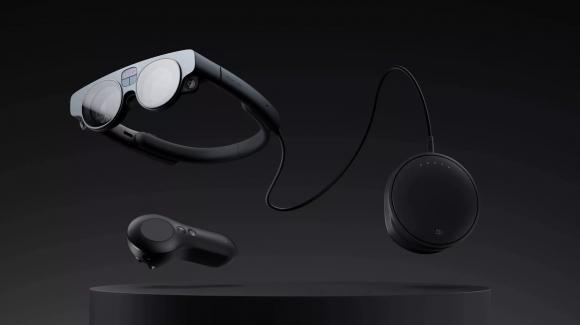Four years after the first version, the new AR Magic Leap 2 viewer from the US hi-tech company of the same name is preparing to make its debut on the market at the end of the summer: this is how it is made and in which kits it will be available for purchase.
Listen to this article
Magic Leap, the US company specialized for over 10 years in creating innovative viewers to apply 3D objects to reality, has announced the arrival on the market for 30 September, in various countries, including the USA and Italy, of its new viewer for augmented reality Magic Leap 2.
The new Magic Leap 2 is lighter (260 grams) and compact than its predecessor, compared to which it also has other improvements: thanks to the ambient light sensor, it is more functional in very bright environments, in which it plays colors (about 17 million ) more solid and faithful, combined with better readability of the text. Technically, the product dedicates to each eye two cameras in charge of tracking its movements, and two displays, one for each eye, of 2.5 megapixels: the result is a visual area of 70 °, with a resolution of 1,440 x 1,760 pixels, 120 Hz. refresh rate, and a peak brightness of 20 thousand nits. On the audio level, it offers two integrated stereo speakers.
Connected via cable to the Magic Leap 2 viewer there is a circular element, which can be attached to the belt, inside which there is first of all the AMD processing system, with an 8-thread Zen2 X86 core quadcore APU, made at 7 nanometers and (interfaced in a shielded way) an AMD GFX10.2 graphics card: the storage is 256 GB while the security is taken care of by the TMR, the AMD Platform Security Processor and the support for WPA3.
Various inertial sensors refer to Magic Leap 2, including 2 altimeters, 2 3-axis magnetometers, 4 sensors for inertial measurement (IMU), 3-axis gyroscope and accelerometer: there is no lack of depth camera, three ultra-wide-angle cameras for shooting reality, a 12.6 megapixel RGB camera equipped with autofocus, capable of shooting from 4K @ 30fps to 1080p @ 60fps. The battery promises 3.5 hours of continuous use, which rises to 7 hours by switching to spleep mode.
For the debut on the market there will be 3 packages. The Basic one, at a cost of $ 3,299, will lend itself to production environments and full commercial applications, with a 1-year warranty. By upgrading to the Developer Pro package, sold for $ 4,099 (again with a 1-year warranty), developers will be able to use pre-release versions of the software and software tools to test and develop apps. The Enterprise package, $ 4,999, with a 2-year warranty and support, will include extra software for business applications.

